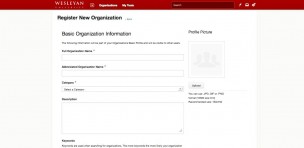
c/o Wesleyan University
The student group platform OrgSync will be replaced with Campus Labs’ Engage platform, which the University renamed WesNest, on Jan. 8, 2020. All student group information on OrgSync will be transitioned to WesNest, and the Student Activities for Leadership Development Office (SALD), Wesleyan Student Assembly (WSA) and the University’s IT department will implement student improvement suggestions to the platform over next spring and summer.
While those working on the transition do not anticipate a steep learning curve for users, they hope that more students will use WesNest and its associated app to engage with campus.
“I really am hopeful that students will find this much more user friendly,” SALD Director Joanne Rafferty said. “Especially now that they have the app and especially seeing as incoming first-year students are going to know how to use this and will be in it from day one, I think we’re going to start to see that this is going to be something students will be in probably on a daily basis.”
Campus Labs, after acquiring OrgSync in 2016, announced it was transitioning all OrgSync profiles to Engage over the next few years. Engage was renamed WesNest by the University so as not to confuse it with Wesleyan ENGAGE, which facilitates civic engagement.
One shift from OrgSync to WesNest is that WesNest will be more focused on the individual student rather than on student groups. Information from all clubs that a student is part of, Rafferty said, will be easily visible on their WesNest profile. The student will no longer have to navigate to different student group pages to receive information.
WesNest also brings a new function that creates a co-curricular résumé for each student based on their participation and positions in various student groups. This will be an official University document, according to Rafferty, that students could attach to their résumés.
Student groups will also have access to more functionalities in WesNest. They will be able to link to their Facebook pages or websites and set up messaging within student groups to communicate without sharing private information. Groups will also be able to conduct surveys through WesNest, and data from these surveys will remain in WesNest for future group members to access.
Students can request to be part of student groups through WesNest, and prospective University students can message the group if they want to hear more information but do not feel comfortable sharing their phone number or email.
In order to ask students about what functionalities they would like the new platform to have, WSA Community Committee Chair Emily McEvoy ’22 sent out an email on Nov. 11 requesting student feedback. Respondents requested clearer ways to check information about their budgets and to see student groups’ meeting times and platforms.
One of the first features that Rafferty plans to have implemented next semester will be linking WesNest with PeopleSoft—a human resource management system used by the University—so student groups can receive their funding immediately after being approved by the WSA Student Budget Committee (SBC) rather than waiting for it to be manually moved.
As those involved in migrating to WesNest learn more about its functionalities, Rafferty is optimistic that viewing financial information will also be more straightforward in WesNest.
“We haven’t done the financial training module yet, so I don’t really know much about that yet,” Rafferty said. “But…from what I’ve seen so far and what I know of OrgSync, this looks so much easier. It’s so much easier to use, it’s so much more user-friendly. And my guess would be that the financial component would be easier as well.”
After connecting WesNest to PeopleSoft, Rafferty plans to link WesNest with EMS room requests so students can more easily request rooms.
For New Student Orientation, Rafferty will use the WesNest app to replace the Guidebook app and integrate WesNest more fully into student culture. She also hopes that, in the future, more departments and other areas of campus will become involved with WesNest so students can engage with them.
To facilitate student engagement with the WSA, McEvoy plans to include more information about the WSA and make it easier for students to reach out to representatives from the WSA Student Life and Academic Affairs Committees in addition to the Community Committee and the SBC. She recognizes the shift that is necessary in the way students perceive WesNest and hopes students will interact more with the new platform.
“We’re kind of eager that it catches on in the way we envision it,” McEvoy said. “I guess we’re unsure of what needs to happen for the campus to have that kind of culture change, to just use an app like that for all student group-related scheduling things. It’s definitely going to be a big shift and we’re really optimistic, but we have no security going into it that it’s gonna work the way we want it to.”
Rafferty plans to hold trainings next semester to educate students on how to use WesNest to its fullest potential, which she views as key to helping students find out how WesNest can best work for them.
“I would say, this is just a total anecdote or my on my own, I don’t think most students really know how to use OrgSync to its full potential,” Rafferty said. “I think that that’s what we’re going to try to change is that you’re going to find this to be useful to you personally, also for your organization, and we will not have met our goal if we can’t say that students know how to use this product and find it useful and are using it daily.”
Jocelyn Maeyama can be reached at jmaeyama@wesleyan.edu.
Comments are closed